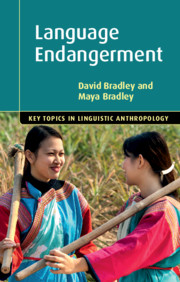Book contents
- Language Endangerment
- Key Topics in Linguistic Anthropology
- Language Endangerment
- Copyright page
- Contents
- Tables
- Acknowledgements
- 1 Introduction
- 2 Stages of Language Endangerment
- 3 Working in a Community
- 4 Identity and Attitudes
- 5 Language Knowledge and Use
- 6 The Sociolinguistic Setting
- 7 Linguistic Processes
- 8 Policy and Planning
- 9 Language Reclamation
- 10 Methodology
- 11 Conclusion
- Glossary of Terms
- References
- Index
- References
5 - Language Knowledge and Use
Published online by Cambridge University Press: 11 November 2019
- Language Endangerment
- Key Topics in Linguistic Anthropology
- Language Endangerment
- Copyright page
- Contents
- Tables
- Acknowledgements
- 1 Introduction
- 2 Stages of Language Endangerment
- 3 Working in a Community
- 4 Identity and Attitudes
- 5 Language Knowledge and Use
- 6 The Sociolinguistic Setting
- 7 Linguistic Processes
- 8 Policy and Planning
- 9 Language Reclamation
- 10 Methodology
- 11 Conclusion
- Glossary of Terms
- References
- Index
- References
Summary
From the perspective of an individual, personal life history, capacities and choices determine their abilities in whatever languages they speak. The outcome for the languages in their repertoire is often that an individual’s knowledge of the dominant language in the larger society will increase, while their knowledge of their in-group endangered language may cease to develop after a certain age, and may even contract. The process of language endangerment is an overall collective outcome of the choices made by individuals, families and communities to acquire and use another language rather than a traditional in-group language, more of the time in progressively more situations.
- Type
- Chapter
- Information
- Language Endangerment , pp. 84 - 119Publisher: Cambridge University PressPrint publication year: 2019

